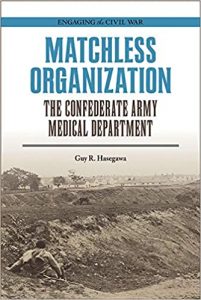Book Review: Matchless Organization
 Matchless Organization: The Confederate Army Medical Department
Matchless Organization: The Confederate Army Medical Department
By Guy R. Hasegawa
Southern Illinois University Press 2021 $26.50 paperback
Reviewed by Stephen Davis
In Doctors in Gray: The Confederate Medical Service (1958), H. H. Cunningham quotes a Southern physician as saying, “we did not do the best we would, but the best we could.” In this new study of the Confederate Medical Department, Dr. Guy Hasegawa demonstrates that despite serious shortages in personnel and supplies, the Richmond-based system did a whole lot more than that.
Former Confederate surgeon Francis Porcher, in a speech delivered in 1899, hailed “the matchless organization of the medical department of the Confederate army.” This may be a little steep, given the accomplishment of its Federal counterpart (think of Jonathan Letterman’s ambulance service). But organization it was indeed. Headed for most of the war by Surgeon General Samuel Preston Moore (who carried the army rank of colonel), the Confederate Medical Department consisted of about 7,400 medical officers—surgeons (majors) and assistant surgeons (captains), perhaps 1,000 contract surgeons (civilians, not allowed to uniform), plus thousands more nurses, cooks, stewards, matrons and laundresses.
The limitations of Civil War medicine are well known. Germ theory lay decades in the future, the medical armamentarium was primitive, and malaria was about the only disease effectively treated (with quinine). Despite these hindrances, Confederate medical officers performed heroically. Americans had obviously not fought so extensive a war as that of 1861, so both sides had to develop dramatically new methods for removing and treating battlefield wounded. Surgeons, stretcher bearers, soldier-nurses, and ambulance drivers were all involved. Systems of field and general hospitals had to be developed.
Hasegawa, who earned his Doctor of Pharmacy degree from the University of California, San Francisco, focuses on the Surgeon General’s Office in Richmond, which oversaw the entire Confederate medical system. Beneath it were medical directors, medical inspectors and medical purveyors. Surgeon General Moore also established medical examining boards to assess surgeons’ qualifications and weed out the bad ones (American medical education was in its infancy).
Matchless Organization highlights both the wartime South’s medical problems and accomplishments. Laboratories were built to produce medicines; what Southerners could not make they tried to import through the blockade, smuggled from the North or captured from the enemy. Citizens donated medicines; retired physicians gave the SGO their operating kits. The South had few experienced makers of medical supplies; a Charleston saddle maker turned out tourniquets. The search for curatives in indigenous plants is in itself an absorbing story. Shortage of wagons hobbled ambulance service; lack of trained personnel limited surgical care in the field armies. Yet among the Confederate medical service’s achievements was the establishment of a monthly medical journal for the publication and promulgation of scientific knowledge and case reporting. All fourteen issues, January 1864-February 1865, were reprinted in 1976 by the New York Academy of Medicine, with an Introduction by William D. Sharpe, M.D. (Dr. Sharpe personally inscribed my copy, one of my library’s prized volumes.)
The importance and extent of the Confederate medical system’s achievements are indicated by one of Dr. Hasegawa’s conclusions: “The persistence and fighting ability of the Confederate military suggest that the Medical Department played a major role in maintaining the army’s strength.” In light of the story told in Matchless Organization, the compliment accorded by one Confederate surgeon—that Dr. Moore headed up “the best organized of all the departments of our army”—not only bears repeating, but remembering.
